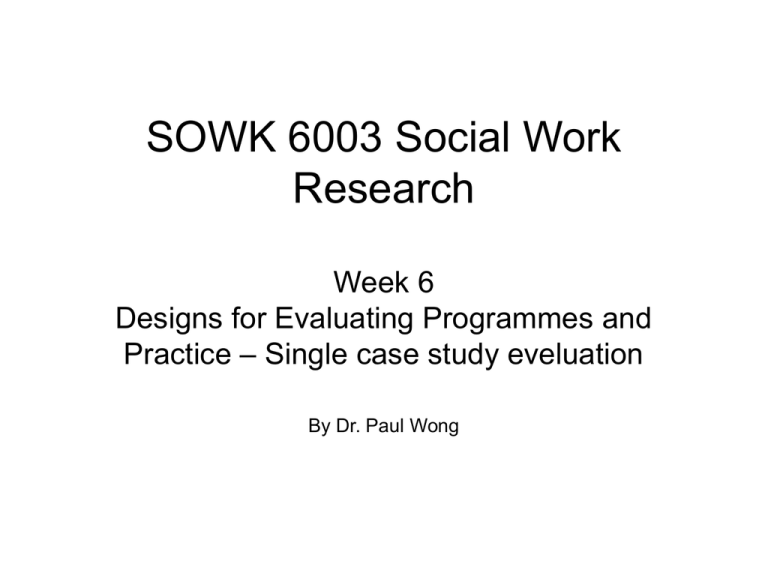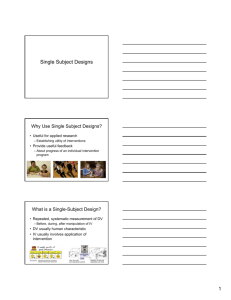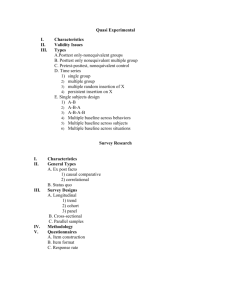PPT
advertisement

SOWK 6003 Social Work Research Week 6 Designs for Evaluating Programmes and Practice – Single case study eveluation By Dr. Paul Wong Purposes of Research 1. 2. 3. 4. 5. Exploration Description Explanation Evaluation Multiple purposes Relationships between Variables • Correlations • Correlational relationship simply says that two things perform in a synchronized manner. Types of Variables Independent Variables (IVs) vs. Dependent Variables (DVs) IV is a variable that explains or causes something, and is not depending on the other variables. It is what the researcher (or nature) manipulates. DV is the variable which is the effect, being explained or caused. When we talk about study design, we need to consider the following aspects: 1. 2. 3. 4. Nature Setting Time Participants Nature – Experimental Design - investigation that involves manipulation and control of an independent or treatment variable with the intent of assessing whether the independent variables causes a change in the level of a dependent variable. Note: Randomization : random assignment to the control and experimental group, which is not equal to random sampling. It is about the reduction of systematic error such as selection bias. – Quasi-Experimental Design - research study set up to resemble a true experiment but that does not involve random assignment of the participants to a group or manipulation and control of a true independent variable, instead relying on measuring groups based on pre-existing characteristics. (Beins, 2009) – Pre-Experimental Design - the features of experimental design and quasi-experimental design are not present. Setting • Applied Research: take place in a natural environment where people are acting as they normally do. It usually attempts to address practical questions rather than theoretical questions • Basic Research is more likely to occur in a laboratory or other controlled setting. It tests or expands on theory, with no direct application intended. (Beins, 2009) Time • One time: Cross-sectional/One shot/Posttest only • Two time: pretest – posttest design • More than two times: Longitudinal • Many many times: Time Series Participant/Subject • One person – Case study • One group – A cohort • More than one person • More than one group – Comparison study Treatment/intervention Data Source • Qualitative – – – – – – – Observations Journal/Diary/Self report Indepth Interview Focus Group Art work Archives Documents • Quantitative – Measurements through self-administered questionnaires (by hand, by mail, or online) – Interview survey (telephone, home visit) – Health indicators (BP, skin temperature, saliva cortisol etc.) Internal validity • Refers to the confidence we have that the results of a study accurately depict whether one variable is or is not a cause of another. Threats to internal validity • Means that whenever anything other than the independent variable can affect the dependent variable. – – – – – History Maturation or the passage of time testing Instrumentation changes Statistical regression, check pp.234-235 for an interesting example – Selection bias – Ambiguity about the direction of causal influence External Validity • Refers to the extent to which we can generalize the findings of a study to settings and populations beyond the study conditions. • *** a major factor that influences external validity is the representativeness of the study sample, setting, and procedures. Research designs that can help us to do evaluation • Single-case design • Quasi-experimental design • Experimental design Why single case study? • Challenges faced by experimental group comparison design – – – – – – Ethical objections Practical problems Generality of findings Inter-subject variability Resources implication: effort, manpower, time and fundings Complex interactions among clients, therapist, technique and socio-environmental variables – More applicable in demonstrating the impact of one set of techniques is greater than another set under broadly defined conditions. There is no information about specific mechanisms of psychological change, and specific technique necessary for such changes. Single Case Study • Also known as: single subject designs, single-case designs, or single-system designs – is a method widely adopted in the early years of psychology in clinical work – studies with single individuals, whether human or nonhuman – can involve multiple cases, but likely to be reported individually – can involve controlled observations, like experiment – data can be collected from questionnaires, naturalistic observations, or physiological measurements – mainly used by behaviorists and clinicians – taking repeated measures of the dependent variable, experimental groups can serve as their own controls Concepts related to single case design • Baseline Phase (A): repeated measures that occurs before intervention, serves as control phase • Intervention Phase (B): repeated measures that occurs during the intervention What, How and Who to measure? Operational indicator(s) based on operational definition of problems or goals (1) When measured by standardized assessment instruments: – Participants might lose interest in completing them carefully over and over again – Biased for social desirability – Test-retest effect (2) When measured by direct behavioral observation: – Availability of observers: practitioners vs significant others vs self – Inter-rater reliability – Unobtrusive vs obtrusive measure (3) When studied by available record: – Consistency – Start intervention earlier with baseline available Single case study designs A-B Design: The basic single case design – popular design with greater feasibility – can be replicated with multiple clients or at multiple settings – provide immediate feedback to clinicians – criticism: it provides no information about the natural course of the behavior would have been had we not intervened with the treatment condition A-B Design with follow-up A-B with follow up and booster treatment • during the follow up period, there is a booster treatment introduced- referred as withdrawal design: • withdrawal of the treatment variable that has been applied after baseline measurement has concluded. • withdraw after change has been successfully demonstrated • a decrease or increase trend in the baseline after the intervention is withdrawn. • more rigorous than the A-B-A design • ethical: providing good clinical care • 2 A-B analysis + 1 B-A analysis A-B with multiple target measures and follow up • attempt to control for extraneous variables by having more than one baseline and intervention phase. • instead of having more than one baseline, multiple baselines are collected simultaneously. • can be done by measuring different client, different measurements, or across different settings • usually, the baseline starts at the same time, the introduction of intervention at different point of time. Qualitative data in single case study • use open-ended interviews with the client or the significant others to try to learn • whether important extraneous events in the client’s social environment coincided with the instability • interviews before baseline can improve our understanding of the target problem, how to measure it, and how best to intervene • information collected from proxy can be used in triangulation format: – – – – – indepth interview video-tape of the intervention open-end question in self-reported questionnaires event logs diary In class activity 1 Article Critique In class activity 2 After class article search: Please find an article/chapter that describes the disadvantages of singlecase study design and summarize it in point form and send to paulw@hku.hk











